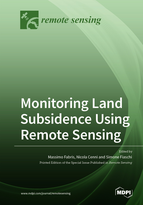Monitoring Land Subsidence Using Remote Sensing
A special issue of Remote Sensing (ISSN 2072-4292). This special issue belongs to the section "Environmental Remote Sensing".
Deadline for manuscript submissions: closed (31 December 2020) | Viewed by 36572
Special Issue Editors
Interests: geomatics; digital aerial photogrammetry; digital surface models; deformations monitoring; 3D surveys; land subsidence
Special Issues, Collections and Topics in MDPI journals
Interests: GPS time series analysis; subsidence; landslide monitoring; seismics; hydrology; applied geophysics
Special Issues, Collections and Topics in MDPI journals
Special Issue Information
Dear Colleagues,
Land subsidence represents a growing problem that affects hundreds of millions of people worldwide. The loss of surface elevation can lead to structural damage of buildings and infrastructures, loss of extensive agricultural and/or natural areas, the rise of salt wedges and the regression of coastlines and can have a significant economic and social impact. This negative impact can be further aggravated by climate changes (e.g., sea level rise), in particular in low-lying coastal areas.
Land subsidence is also one of the major factors controlling the geomorphological evolution of river basins and deltaic areas, which can host large population centres and extensive productive activities.
Ground deformations monitoring plays a key role in the management of such natural hazard by providing cost-effective solutions for risk mitigation.
This Special Issue of Remote Sensing is devoted to all topics related to land subsidence monitoring using remote sensing techniques (in particular, but not limited, to InSAR) complemented with ground-based data (e.g., GNSS, precise levelling).
Land subsidence can generally be considered as a superposition of natural processes and anthropogenic activities. Therefore, papers in which these different contributions are explained and estimated are welcome. Papers discussing theoretical models, the results obtained from monitoring activities and the evolution in space and time of land subsidence processes are also welcome. We particularly encourage the submission of manuscripts presenting new and/or innovative applications of remote sensing techniques for the monitoring and quantification of land subsidence.
Prof. Dr. Massimo Fabris
Dr. Nicola Cenni
Dr. Simone Fiaschi
Guest Editors
Manuscript Submission Information
Manuscripts should be submitted online at www.mdpi.com by registering and logging in to this website. Once you are registered, click here to go to the submission form. Manuscripts can be submitted until the deadline. All submissions that pass pre-check are peer-reviewed. Accepted papers will be published continuously in the journal (as soon as accepted) and will be listed together on the special issue website. Research articles, review articles as well as short communications are invited. For planned papers, a title and short abstract (about 100 words) can be sent to the Editorial Office for announcement on this website.
Submitted manuscripts should not have been published previously, nor be under consideration for publication elsewhere (except conference proceedings papers). All manuscripts are thoroughly refereed through a single-blind peer-review process. A guide for authors and other relevant information for submission of manuscripts is available on the Instructions for Authors page. Remote Sensing is an international peer-reviewed open access semimonthly journal published by MDPI.
Please visit the Instructions for Authors page before submitting a manuscript. The Article Processing Charge (APC) for publication in this open access journal is 2700 CHF (Swiss Francs). Submitted papers should be well formatted and use good English. Authors may use MDPI's English editing service prior to publication or during author revisions.
Keywords
- Land subsidence
- Anthropogenic and natural components
- Climate change impact
- Time series analysis
- Remote sensing monitoring techniques
- InSAR
- Integrated monitoring approaches







